
Gatineau’s housing crisis, driven by low vacancy rates, rising rents, and insufficient affordable supply, is deepening according to a new IRIS report, which warns that without structural reforms and greater public intervention, the city’s most vulnerable residents will be increasingly left behind. Photo: Tashi Farmilo
Gatineau’s housing crunch deepens as IRIS report dismantles market myths
Tashi Farmilo
What once made Gatineau a haven from big-city housing costs—lower rents, more space, and a growing stock of new builds—is quickly slipping out of reach. A new report from the Institut de recherche et d’informations socioéconomiques (IRIS), released in May 2025, confirms what many residents already feel: the housing crisis is no longer creeping in from elsewhere—it’s here, entrenched, and accelerating.
Titled Le filtrage comme mirage de solution à la crise du logement, the report critiques the idea that simply building more market-rate housing will “filter down” to affordability. IRIS argues that over-reliance on the private sector, without robust public investment or regulation, has led to fragmented housing markets that systematically exclude low- and middle-income households.
The report identifies two core problems: the spread of “filtering” as a misleading policy fix, and the increasing commodification of housing. Province-wide, 31% of renter households in Quebec spend more than 30% of their income on rent, while 9.5% spend over half—clear indicators of housing stress. Gatineau is particularly vulnerable due to persistent affordability gaps and population growth driven by migration from Ontario.
Recent local data bears this out. Gatineau’s vacancy rate for purpose-built rentals rose modestly to 1.9% in 2024, still well below the 3% benchmark for market balance, according to the Canada Mortgage and Housing Corporation (CMHC). Average monthly rent for a two-bedroom apartment reached $1,353 and is projected to rise to $1,431 in 2025. Newer units often exceed $1,600, placing them far beyond the reach of many households.
While housing starts reached record levels in 2024, early 2025 shows signs of slowdown amid rising costs, labour shortages, and infrastructure bottlenecks. IRIS contends the deeper issue lies in the private sector’s incentive structure: new construction overwhelmingly targets higher-income brackets, with little obligation to provide affordable units.
As a counterbalance, the report calls for a significant expansion of non-market housing. Gatineau has committed $92 million from 2022 to 2025 toward community and subsidized housing, aiming to deliver 1,300 units. But IRIS argues that this is far from sufficient. The report urges stronger public leadership—support for housing co-operatives, expanded rent control, and protections against renovictions.
Across Gatineau, the strain is visible. In Hull, tenants face aging rental stock and displacement pressures; in Aylmer, new construction has driven average rents well above affordable thresholds. Central Gatineau offers virtually no availability for modestly priced units, while outer sectors like Masson-Angers and Buckingham suffer from limited supply and poor transit access. Renters across the city face mounting pressures—from rising costs to insecure conditions. Without meaningful reform, IRIS warns, housing insecurity will continue to deepen.
As Gatineau approaches 305,000 residents, the report delivers a blunt conclusion: supply alone won’t solve the crisis. Without structural change that treats housing as a public good rather than a commodity, thousands risk being left behind in a city increasingly out of reach.
